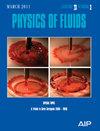分层流中皮层厚度对水平圆柱体尾流的影响
IF 4.1
2区 工程技术
Q1 MECHANICS
引用次数: 0
摘要
本研究探讨了在圆柱体上的二维分层流中,pycnocline 厚度的调节作用。它包括 Boyer 在 Re = 260-2000 雷诺数范围内进行的实验中确定的三种典型流动状态。通过改变pycnocline的厚度,可以定量控制内界面波对圆柱体尾流的调制效应。在适当的pycnocline厚度下,多中心线结构可过渡到孤立-混合结构流态和双-Eddy-Wave-Wake流态。在孤立混合流态中也观察到类似的调制模式。归一化压力分布和速度场表明,在低雷诺数流态(Re < 600)中,下游孤立混合区产生的动态压力会周期性地向上游串联。这种周期性的反向能量传递提供了有利的逆向压力梯度,周期性地降低了气缸上的阻力。循环周期首次被划分为四个阶段:动压储存阶段、动压传递阶段、动压消耗阶段和动压耗尽阶段。尽管内界面波在低雷诺数条件下具有高度非线性的调制效应,但基于流线方程的利波线性预测理论对预测利波波长随pycnocline厚度的变化趋势仍具有指导意义。借鉴有关跃层厚度对利波的调制研究结果,构建了一个波形图,说明了基于跃层厚度变化的利波流动模式的方向性演变。本文章由计算机程序翻译,如有差异,请以英文原文为准。
Modulation of the wake of a horizontal cylinder by pycnocline thickness in stratified flow
This study investigates the modulating effect of the pycnocline thickness in two-dimensional stratified flow on a cylinder. It encompasses three typical flow regimes identified by Boyer in experiments conducted within the Reynolds number range of Re = 260–2000. Quantitative control of the modulation effect of internal interface waves on the cylinder wake is achieved by varying the thickness of the pycnocline. Under appropriate thickness of the pycnocline, a multiple-centerline-structure can transition to isolated-mixed-structure flow regimes and Double-Eddy-Wavy-Wake flow regimes. Similar modulation patterns are also observed in isolated-mixed flow regimes. Normalized pressure distribution and velocity fields indicate that in low Reynolds number flow regimes (Re < 600), downstream isolated mixed regions generate dynamic pressure that periodically cascades upstream. This periodic reverse energy transfer provides favorable adverse pressure gradients, cyclically reducing the drag force on the cylinder. The cyclic period is, for the first time, classified into four stages: dynamic pressure storage stage, dynamic pressure transfer stage, dynamic pressure consumption stage, and dynamic pressure exhaustion stage. Despite the highly nonlinear modulation effect of internal interface waves in low Reynolds number conditions, the linear predictive theory of lee waves based on streamline equations remains instructive in predicting the trend of lee waves wavelength variation with pycnocline thickness. Drawing upon the modulation study results concerning the pycnocline thickness on lee waves, a regime map is constructed, illustrating the directional evolution of lee waves flow patterns based on variations in pycnocline thickness.
求助全文
通过发布文献求助,成功后即可免费获取论文全文。
去求助
来源期刊

Physics of Fluids
物理-力学
CiteScore
6.50
自引率
41.30%
发文量
2063
审稿时长
2.6 months
期刊介绍:
Physics of Fluids (PoF) is a preeminent journal devoted to publishing original theoretical, computational, and experimental contributions to the understanding of the dynamics of gases, liquids, and complex or multiphase fluids. Topics published in PoF are diverse and reflect the most important subjects in fluid dynamics, including, but not limited to:
-Acoustics
-Aerospace and aeronautical flow
-Astrophysical flow
-Biofluid mechanics
-Cavitation and cavitating flows
-Combustion flows
-Complex fluids
-Compressible flow
-Computational fluid dynamics
-Contact lines
-Continuum mechanics
-Convection
-Cryogenic flow
-Droplets
-Electrical and magnetic effects in fluid flow
-Foam, bubble, and film mechanics
-Flow control
-Flow instability and transition
-Flow orientation and anisotropy
-Flows with other transport phenomena
-Flows with complex boundary conditions
-Flow visualization
-Fluid mechanics
-Fluid physical properties
-Fluid–structure interactions
-Free surface flows
-Geophysical flow
-Interfacial flow
-Knudsen flow
-Laminar flow
-Liquid crystals
-Mathematics of fluids
-Micro- and nanofluid mechanics
-Mixing
-Molecular theory
-Nanofluidics
-Particulate, multiphase, and granular flow
-Processing flows
-Relativistic fluid mechanics
-Rotating flows
-Shock wave phenomena
-Soft matter
-Stratified flows
-Supercritical fluids
-Superfluidity
-Thermodynamics of flow systems
-Transonic flow
-Turbulent flow
-Viscous and non-Newtonian flow
-Viscoelasticity
-Vortex dynamics
-Waves
 求助内容:
求助内容: 应助结果提醒方式:
应助结果提醒方式:


